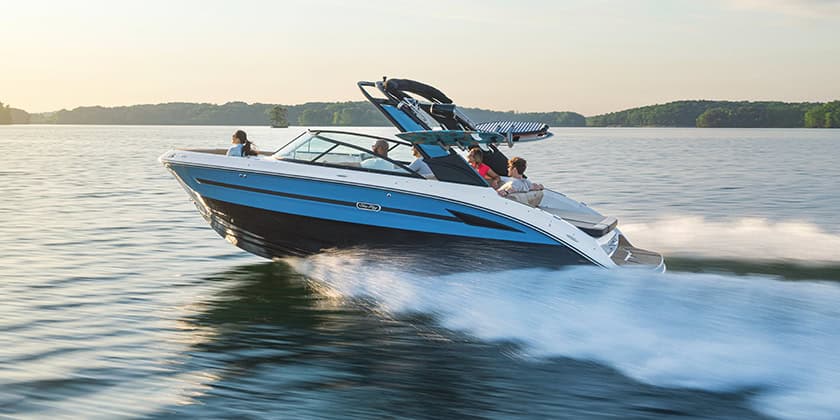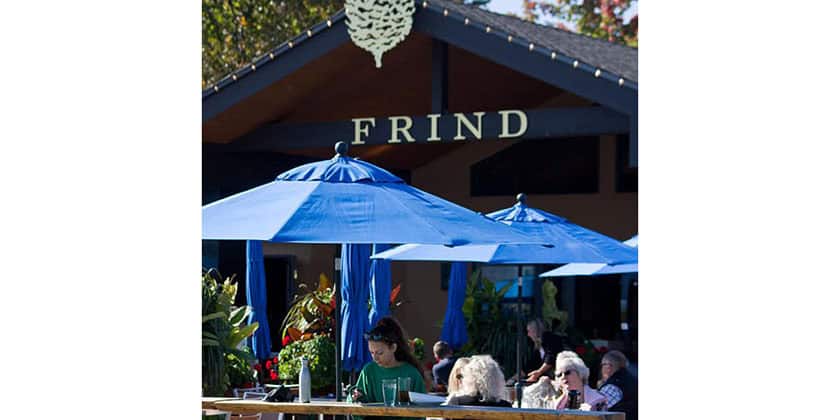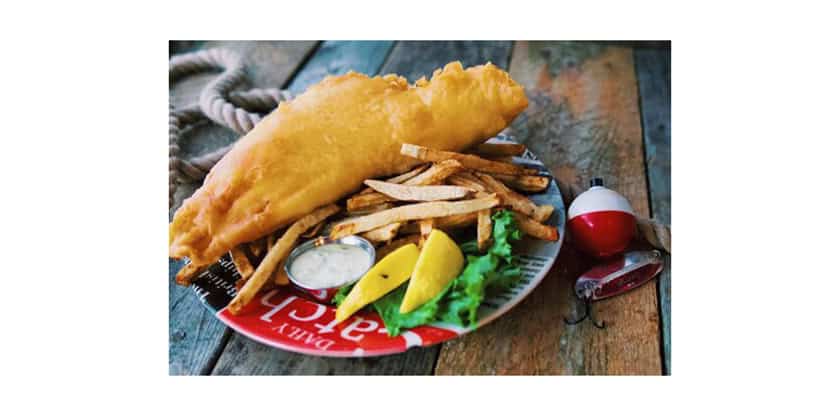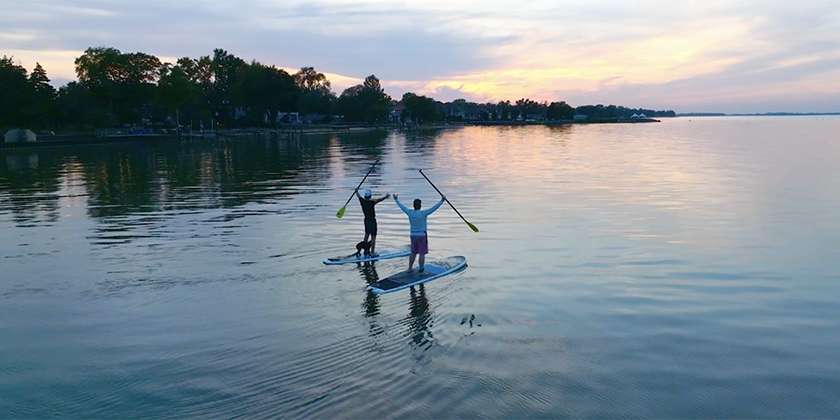Dufour 430 Grand Large
By Peter A. Robson
A top-quality French cruiser that ticks all the boxes
Without the optional bow thruster, getting the new Dufour 430 out of the impossibly crowded docks at Vancouver’s Granville Island was a challenge, but long-time broker Richard Hargreaves got us out without mishap. Also aboard was Richard Carrier from One4 Yachts. We’d been watching the Windy app for weeks, waiting for enough wind to put the new Dufour 430 through its paces. Finally, today’s winds were forecast at 15 to 20 knots.
Dufour Yachts was established in 1964, and today the La Rochelle-France based company counts itself among the biggest shipyards in the world. Currently, Dufour produces 11 sailboat models from 31 feet (9.67 m) to 63 feet (19.2 m).
The 430 Grand Large is one of the next generation series Dufours designed by Italian naval architect Umberto Felci. It is a brand new three-cabin, two-head model with a single spade rudder and twin wheels. Its L-shaped keel is relatively deep with a standard draft of 6′ 9″ (2.1 m). The beam on the 430, like other new next generation models, has been carried further forward than older model Dufours. This means more interior room. A number of other design changes brought down from its larger next-gen siblings give the 430 a sleeker, more modern styling.
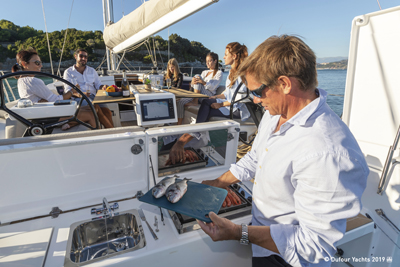 The transom barbecue allows the chef to be part of the action on deck.
The transom barbecue allows the chef to be part of the action on deck.
Upon boarding from the folding swim platform, one will notice the barbeque, sink and food prep area built into the top of the transom. Chefs can work their magic while facing those in the cockpit. When not in use, the transom becomes transverse cockpit seating area. The twin wheels, cockpit table and cockpit bench seating are quite similar to other similar-size sailboats while offering plenty of room to move around. The side decks are wide, and passage forward past the lower shrouds, which often involves acrobatics, is surprisingly easy. The deck is nicely clear of any tripping hazards and the mostly flush, smoked-glass skylights and hatches add to its clean look.
Belowdecks, the biggest departure from the norm is the forward galley. Putting a galley between the salon and the bow master is only possible because the beam of the 430 has been carried far enough forward to provide the necessary room. While initially skeptical of this layout, it actually has a number of benefits.
 (left) The forward cabin.
(left) The forward cabin.
First, it provides for two work areas, one to port and one to starboard of the centreline. This allows two people to work in the galley without tripping over each other. Being amidships also allows great natural light from expansive overhead skylights. Second, the L-shaped main galley section faces aft and is wide open to the rest of the salon and this creates a cozy open feel. The main settee and dinette table are offset to starboard and face a fixed dinette bench seat. This eliminates the issue of struggling to get past a centerline dinette table as nothing blocks passage from the companionway to the forward cabin. As an added benefit, the backrest of the dinette bench doubles as a handrail. To port, across from the fixed bench, is a settee with a base that slides out so that the back cushions are angled to become a comfy recliner. The chart table/nav station (with switching panel) is on brackets that allow it to be lowered to make a longer settee berth.
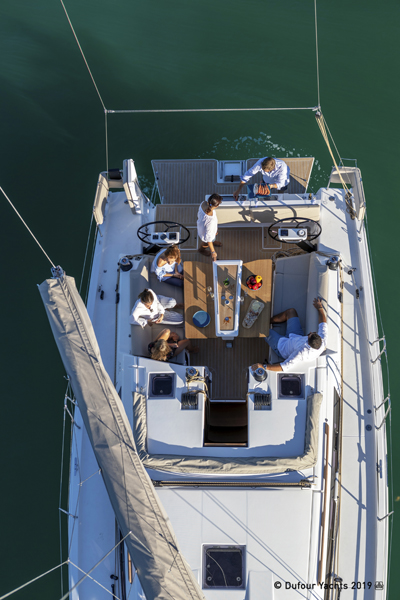
(right) There’s plenty of room to move around the cockpit—and plenty of room for entertaining.
With the first of two heads immediately to the left of the companionway stairs, it’s only few feet to the separate shower compartment, and this makes an excellent, easily accessible place to hang wet gear. The test boat came with manual flush saltwater toilets and vessel sinks.
Wooden valances run the length of the cabin and not only hide indirect lighting, but double as handrails. Cruisers will also appreciate the ample storage not only throughout the vessel, but also in handy under-deck cabinets (with gas pistons for gentle operation) that run the length of the salon.
The 430 is available with a three- or four-cabin layout however, I can’t see going with the four-cabin option as it would detract from the open feel of the salon. The three-cabin layout is much, much nicer, with a bow master and two guest staterooms (with playground-size mattresses) flanking the companionway.
The master’s island queen is surprisingly wide at the head end, thanks to the beam being carried forward. Also unusual is the large divided hanging locker with great hanging space as well as shelf storage. The hull windows offer wonderful visibility from the bed. And of course, the ensuite is an added bonus.
 The forward galley and the offset dinette create a cozy, open feel in the salon.
The forward galley and the offset dinette create a cozy, open feel in the salon.
Overall, the interior is very well styled, with oak floorboards (which didn’t squeak or flex) and oak, horizontally-grained veneers on the bulkheads and cabinetry. This contrasted nicely with beige cushions and gray Corian countertops. The wood mouldings and corner pieces were unusually robust. I was impressed by the stiff interior bulkheads. As an example, the walls of the head barely flexed the adjacent walls when the door was shaken.
Engine and Systems
The test boat came with the upgraded 60 hp Volvo diesel with Saildrive and a fixed three-blade prop. Four AGM house batteries with a total capacity of 380 aH (as well as an engine start battery) should provide ample power for anchoring over the weekend. Both the engine and shore power can heat the 40 L hot water tank.
Underway
Once clear of False Creek, we did some speed runs under power. At 2,500 rpm we were making 7 knots and at 3,000 rpm we topped out at 8 knots. Sound level in the saloon at 2,500 rpm was a surprisingly quiet 68 dB.
 The galley is open to the salon, not tucked into an aft corner as usual.
The galley is open to the salon, not tucked into an aft corner as usual.
The 12-inch Raymarine Axiom flat screen chart plotter inset into the aft end of the cockpit table can be easily seen and operated from either helm station, something that is not always the case. Pods on top of each helm station hold the wind instruments, autopilot and engine gauges.
The deck-stepped, aluminum, two-spreader Seldon fractional rig comes with stainless rigging and a split, non-adjustable backstay. Hoisting the fully battened main from the stack pack was made easy thanks to the electric Lewmar T40 winch mounted on the cabin top. The double ended mainsheet was led to the single, easily-accessible manual Lewmar T50 sheet winch fronting each helm. The traveller was fed through the cabin-top clutch arrays that flank the companionway.
Of course, once the 95 percent self-tacking jib was unfurled and sheeted in for close hauled sailing, it needed no attention.
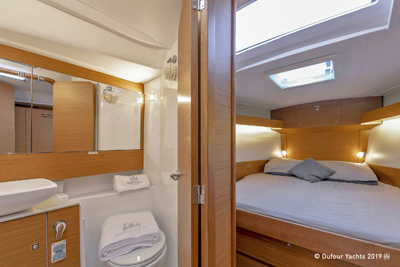 The master ensuite is much larger than the guest head, but at the expense of a separate shower compartment. Note the ample width of the bed at its forward end.
The master ensuite is much larger than the guest head, but at the expense of a separate shower compartment. Note the ample width of the bed at its forward end.
While the forecast winds didn’t materialize, we did manage to sail in as much as 12 knots at times—and that was enough to heel nicely and make it a pretty well perfect fall sailing day. Steering under sail was a real treat; the helm was silky smooth and well balanced (at least in our light conditions). Upwind in 8 knots of true wind, our speed was between 4.5 to 5 knots and at 10 knots we were making an average speed of just over 6 knots. Those are pretty good numbers for a cruising yacht. The 430 felt a tiny bit sluggish in anything less than about 8 knots of wind. However, with 10 to 12 knots, the 430 really came into its own, settling in nicely on its chine. It is well known that while self-tackers make it easy for upwind sailing, they don’t add much when the vessel is off the wind. We didn’t have a Code 0 or an asymmetrical sail on board, but I sure would have liked to give it a try in those conditions.
The 430 proved a capable cruiser for weekend or extended cruising and its solid feel and construction make it a go-anywhere vessel. For some inside information, we talked to Tom Allan from Seattle. He and his wife purchased a 430 in 2019. They use it extensively (177 hours on the engine alone). The transom barbeque and the midship galley were real selling points for him and his wife. He also noted the quality construction and fit and finish. He added that the 430 was an excellent platform for entertaining even large numbers of guests as well as being a comfortable boat to spend a lot of time aboard. Price as tested in Vancouver was $453,980 Cdn,
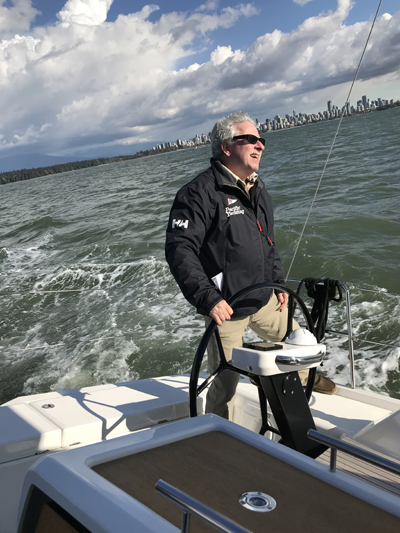
The author at the helm with the Vancouver skyline in the background
SPECIFICATIONS
LOA: 13.24 m / 43′ 5″
Hull length: 12.50 m / 41′
LWL: 11.69 m / 38′ 4″
Beam: 4.30 m / 14′ 1″
Draft standard 2.10 m / 6′ 11′
Draft shallow: 1.75 m / 5′ 9″
Keel weight, standard 2.6 t / 5,732 lbs
Displacement
Light 9.7 t / 21,385 lbs
Engine, std: Yanmar 50 hp Diesel w/Saildrive
Engine, optional: 60 hp
Fuel tank: 250 L / 66 USG
Fresh water: 430 L / 114 USG
Hot water: 40 L / 10.5 USG
Holding: 53 L / 14 USG
Category: European Directive 2013-53-EU Category A
Mast length above WL: approx. 19.2 m / 63′
Total sail area: 92 sqm / 990 sq ft
Main sail: 52 sqm / 560 sq ft
Self-tacking jib: 40 sqm / 431 sq ft
Price as tested: $453,980 Cdn.
Test boat and pricing provided by: Yacht Sales West, Vancouver, BC, (604) 488-1202
Test boat provided by: Yacht Sales West
Pricing provided by: Yacht Sales West
Website: yachtsaleswest.com,.dufour-yachts.com










